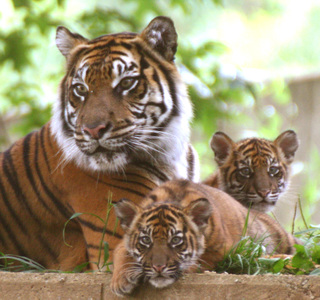Ranthambore National Park of India has a great 2011 start with the news of 9 tiger cub births.
Ranthambore, which is one of the largest National Park of India, is widely known for its Tigers. The Sanctuary was one of the initial reserved area to come under Indian Governments ‘Project Tiger’ in 1973. In 80s the park saw increase of tiger population slowly reaching 44 in 1989. But this critically endangered species saw a decline of population in 90s and later. The main reason for the population decline is attributed to poaching and habitat loss. In 2005 the official survey reveals only 24 tiger in the park. With tremendous efforts from wildlife activists and forest department, the population again soared to around 34 in 2008. According to the census conducted in the core division in 2009, revealed there were 14 males, 16 females and 10 cubs.
But 2010 brought no good news for Tigers in Ranthambore with around 10 tiger lives lost. Due to tiger population growth and habitat shrinking, there were fierce competition among the tigers for food and territory. Apart from deaths due to fights, a few of them found staryed away from the National park. Adding worse to the scenario, in March 2010, two tiger cubs were poisoned by local villagers!
Though 2010 was not a very good year, 2011 brings really joy to the Ranthambore National park with news of nearly 9 or more new born cubs.
A trap camera caught three cubs recently in the Indala region of the park. Though the news of the birth of the cubs at the Indala region came sometime back, forest officials could not confirm it as pictures were not available. According to Rajpal Singh, member of the state wildlife board, the Indala tigress was the same one that gave birth to three cubs in 2006. Unfortunately, none of those survived.
Since last September, five cubs have been caught on camera while forest guards spotted two more tigress which are said to be lactating, park sources said.
However, sources said that there are four more cubs have been spotted in separate areas in the park. These four cubs are in two separate areas of the park. But there is no official confirmation on them as of now.
We hope this time the cubs will grow up with good health and authorities will take proper measure for this increasing population.



Recent Comments